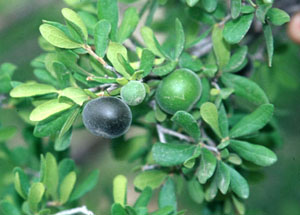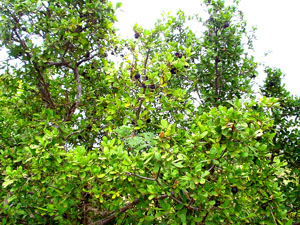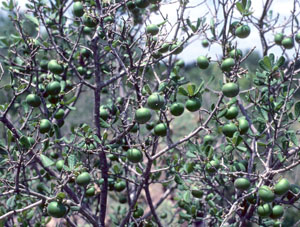Texas Persimmon
Diospyros texana Scheele
Ebenaceae (Persimmon Family)
Texas persimmon is a shrub or small-tree that produces black berries. Its astringent fruit was used for food and medicine, and its tough wood was used to make digging sticks. The bark is smooth and gray, sometimes peeling off in thin sheets. The male and female flowers grow on separate plants, and when persimmon are ready to harvest, it is not uncommon to see a barren tree standing next to a tree laden with fruit. Texas persimmon is widespread and abundant throughout the South Texas Plains (Everitt and Drawe 1992). Texas persimmon fruit is remarkably acidic (Tull 1987:213). Surprisingly, the documented medicinal uses of the plant far outnumber notations of its food use. Read on to explore the many uses of this interesting little shrub.
Archeological occurrence. There are no reported occurrences of persimmon seeds from archeological sites located in the South Texas Plains, primarily because so few archeological excavations have been conducted there. However, persimmon seeds are abundant in the well-preserved rockshelter deposits of the Lower Pecos, located just to the west of the area (Alexander 1974; Dering 1979; Irving 1966). The seeds have even been found in coprolites (dried human feces) from Hinds Cave (Williams-Dean 1978), obviously having passed through the digestive tract of an overeager berry consumer. Tools made from persimmon wood were identified in the deposits of Hinds Cave near the Pecos River, and from Shumla Cave Number 5 on the Rio Grande.
Food use. Texas persimmon is a rare case where the weight of the archeological evidence for indigenous use far outstrips the ethnographic documentation. While archeological specimens abound, there is only one mention of Texas persimmon in the ethnographic literature, and it is listed under the obsolete name, Brayodendron texanum. The authors briefly mention that the Comanche ate raw persimmons (Carlson and Jones 1940).
Medicine. The fruit of Texas persimmon is similar to that of eastern persimmon (Diospyros virginiana), and the uses were probably similar as well. The primary difference is that the Texas persimmon is much darker and even more astringent and acidic than its eastern relative. A brief examination of the ethnography of eastern persimmon suggests other possible uses of the Texas persimmon.
Perhaps most important is the use of the fruit as an astringent for treating sores in the throat and mouth, practiced by the Cherokee. They also used that quality of the fruit to treat hemorrhoids, and they chewed the bark to treat heartburn (Hamel and Chiltoskey 1975).
The author learned the intense acidic and astringent qualities of Texas persimmon on a hot August afternoon. Hiking, hot, and out of water, this author (then a graduate student) decided to eat several persimmons to slake his thirst. This was not a good idea, because his mouth felt drier for the trouble, and his stomach, empty of water, had a problem with the acidic quality of the persimmons, which resulted in the discovery of the emetic qualities of the fruit. This application is not mentioned in the ethnographic record, but no further confirmation is needed.
References:
Alexander, Robert K.
1974 The Archeology of Conejo Shelter: A Study of Cultural Stability at an Archaic Rockshelter Site in Southwestern Texas. Ph.D. dissertation, University of Texas at Austin.
Carlson, Gustav G. and Volney H. Jones
1940 Some Notes on Uses of Plants by the Comanche Indians. Papers of the Michigan Academy of Science, Arts, and Letters 25:517-542.
Dering, J. Philip
1979 Pollen and Plant Macrofossil Vegetation Record Recovered from Hinds Cave, Val Verde County, Texas. Masters Thesis. Texas A&M University. ) Pulblished by the Department of Anthropology.
Everitt, J. H. and D. L. Drawe.
1992 Trees, Shrubs, and Cacti of South Texas. Texas Tech University Press. Lubbock.
Hamel, Paul B. and Mary U. Chiltoskey
1975 Cherokee Plants and Their Uses -- A 400 Year History. Herald Publishing Co., Sylva, N.C.
Irving, Robert S.
1966 A Preliminary Analysis of Plant Remains from Six Amistad Reservoir Sites. In A Preliminary Study of the Paleoecology of the Amistad Reservoir Area, ed. by Dee Ann Story and V. M. Bryant, Jr., pp. 61-90. National Science Foundation Final Report (GS-667).
Tull, Delena
1987 Edible and Useful Plants of Texas and the Southwest: A Practical Guide. University of Texas Press. Austin.
Williams-Dean, Glenna
1978 Ethnobotany and Cultural Ecology of Prehistoric Man in Southwest Texas. Anthropology Research Laboratory. Texas A&M University. College Station, Texas.


